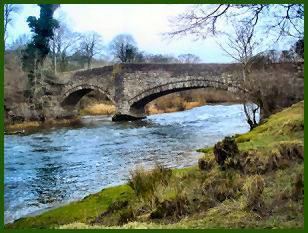Length 71 km Country United Kingdom | Source Wath Mouth elevation 0 | |
 | ||
Bridges | ||
The River Lune (archaically sometimes Loyne) is a river of 53 miles (85 km) length in Cumbria and Lancashire, England.
Contents
Map of River Lune, United Kingdom
SpringsEdit
The river begins as a stream at Newbiggin, in the parish of Ravenstonedale, Cumbria, at St. Helen's Well (elevation of 238 metres above sea level) and some neighbouring springs. On the first two miles of its course, it is joined by four streams, two of them as short as itself, but two ones much longer. These are the Bessy Beck (short), the Dry Beck of 4.9 km (three miles) length at 0.32 miles from St. Helen#s Well, the Sandwath Beck (short) at 0.37 miles, and the Weasdale Beck (5.58 km = 3½ mls) at 1.6 miles from the well. Weasdale Beck is the uppermost headwater of River Lune recorded in Environment Agency's Catchment Data Explorer.
Course and valleysEdit
It then passes the remnants of a Roman fort near Low Borrowbridge at the foot of Borrowdale, and flows through south Cumbria, meeting the Irish Sea at Plover Scar near Lancaster, after a total journey of about 53 miles (85.6 km).
The valley of the Lune has three parts. The northern part between its source and Tebay is called Lunesdale. Below this is the spectacular Lune Gorge through which both the M6 motorway and the West Coast Main Railway Line run. Below the gorge, the valley broadens out into Lonsdale.
Bridges over the Lune include the Devil's Bridge near Kirkby Lonsdale and the Lune Millennium Bridge in Lancaster. At Caton, about 5 miles (8 km) upstream from Lancaster, there is a cluster of three bridges (one stone road bridge and two disused iron rail bridges now used as foot/cyclepaths) at the Crook o' Lune. Here in a 180-degree right-hand bend the Lune turns back on itself; this is followed by a 90-degree left-hand bend forming the shape of a shepherd's crook and creating a beauty spot which was painted by J. M. W. Turner.
EstuaryEdit
Near the end of the non-tidal reach of the river stands the Lune Aqueduct, which carries the Lancaster Canal. The Lune is now tidal only below Skerton Weir in Lancaster. Four bridges in close proximity cross the estuary in Lancaster: Skerton Bridge (road), Greyhound Bridge (built as rail but now carries a road), Lune Millennium Bridge (pedestrian and cycle) and Carlisle Bridge (carrying the West Coast Main Line railway, and with a public walkway on the eastern side) which is the furthest downstream of the bridges. A Lancaster western bypass has been under discussion for many years. If it ever proceeds, a new bridge would be built downstream from Carlisle bridge.
This part of the Lune is also the site of the old Port of Lancaster, probably a port from Roman times; the Lancaster Port Commission was established in 1750 to improve navigation on the estuary. Between 1750 and 1767, St George's Quay and New Quay were built in Lancaster and in 1779 the port facilities were extended closer to the Irish Sea at Glasson Dock. In 1847 the Commissioners built a pair of lighthouses near Cockersand Abbey to help guide ships into the port. The lower lighthouse, known as the Plover Scar Lighthouse, (sometimes called Abbey lighthouse) still stands on Plover Scar, and it remains operational. The old high light, a square wooden tower, was demolished in 1954; but the former keepers' cottage, built alongside the high light, can still be seen.
Lancaster (and hence also Lancashire) is named after the Lune. The name of the ancient hundred of Lonsdale is also derived from the river. The river is a County Biological Heritage Site.
EtymologyEdit
There are these theories about the name "Lune":
- From a Romano-British word meaning "clean", "pure".
- Via Anglo-Saxon Ēa Lōn (ēa = "river") as a phonetic adaptation of a Romano-British name referring to a Romano-British god Ialonus who was worshipped in the area.
- Lune is the crescent shape of the oxbow in the river. Lune is generic for a river with prominent oxbow.
